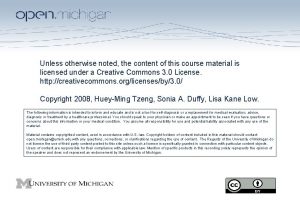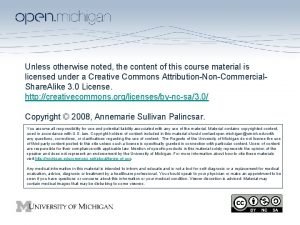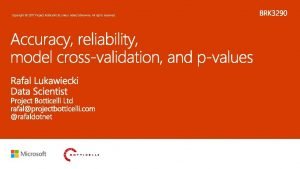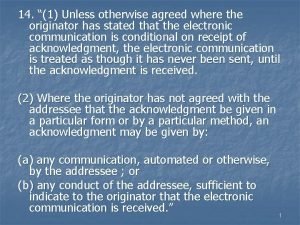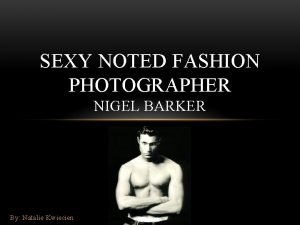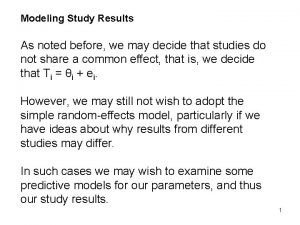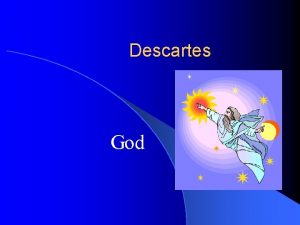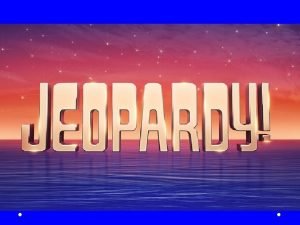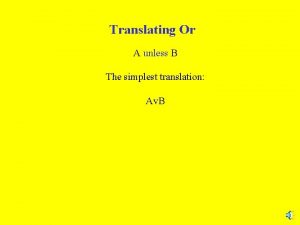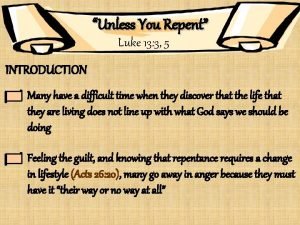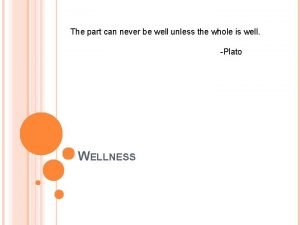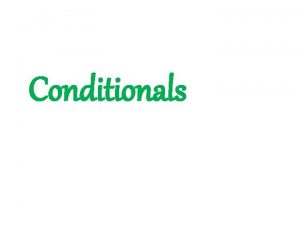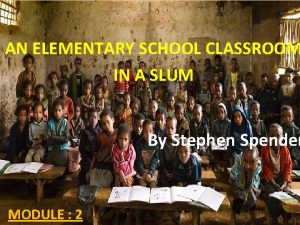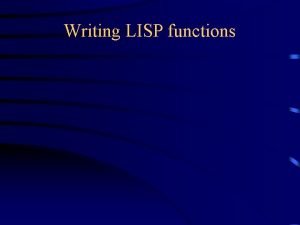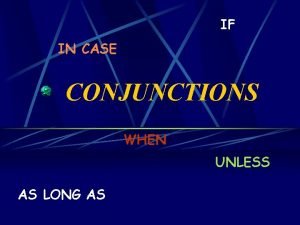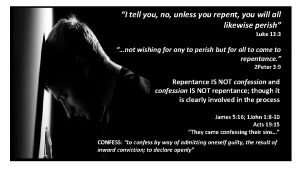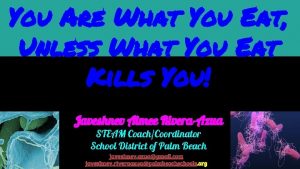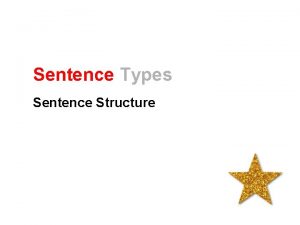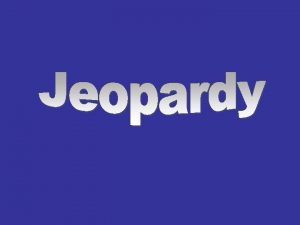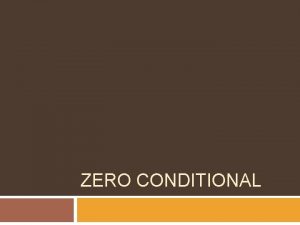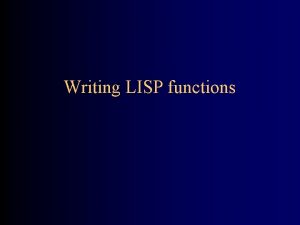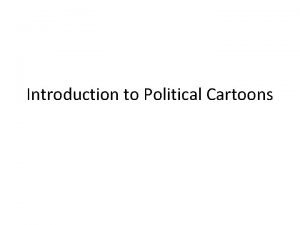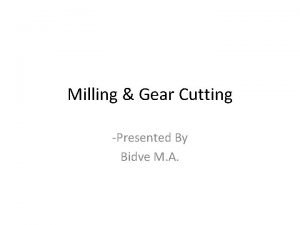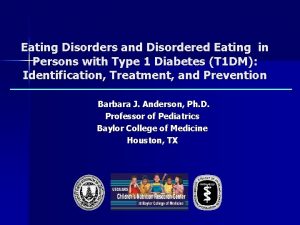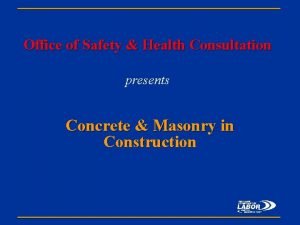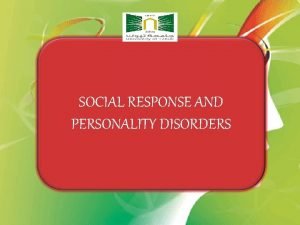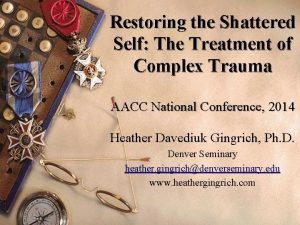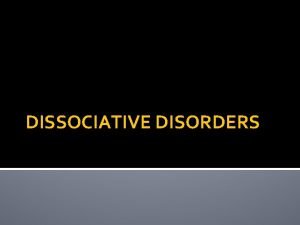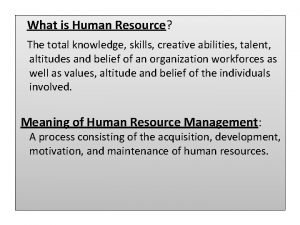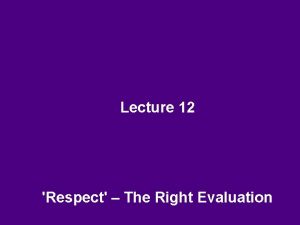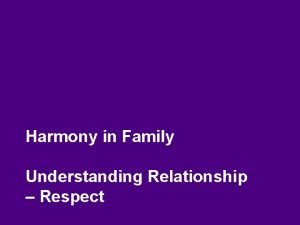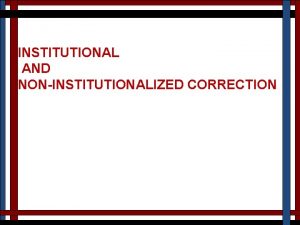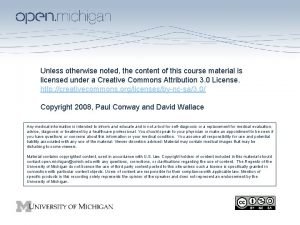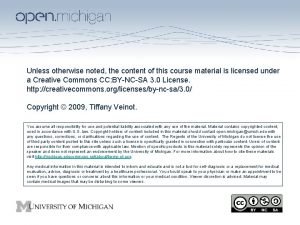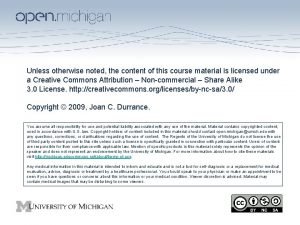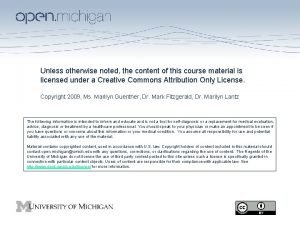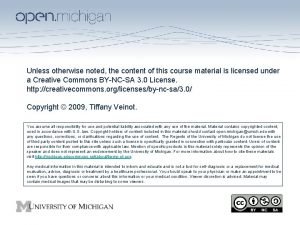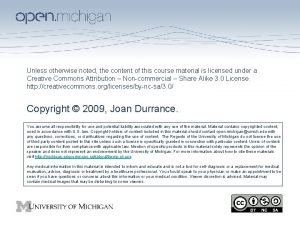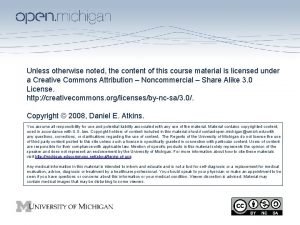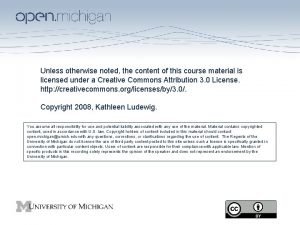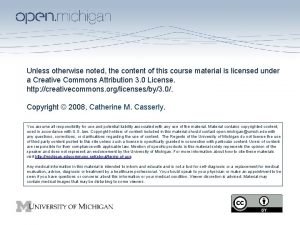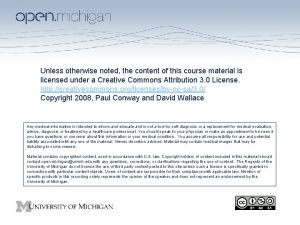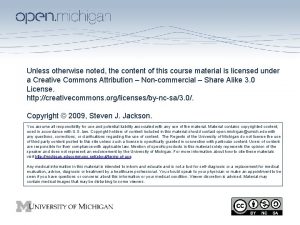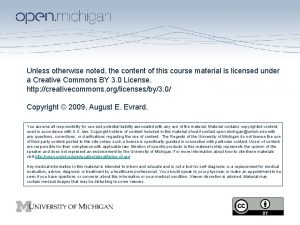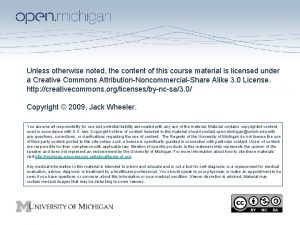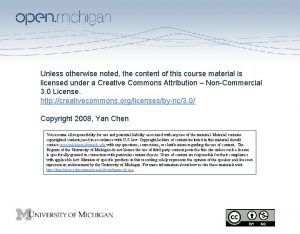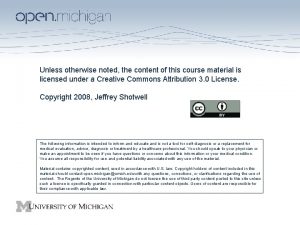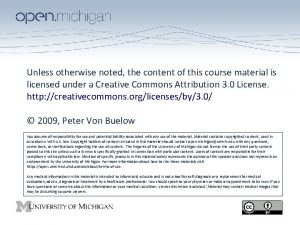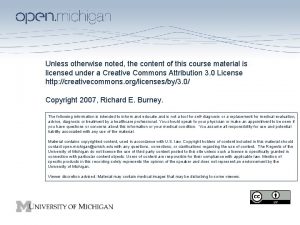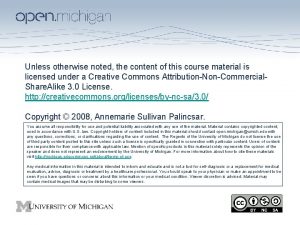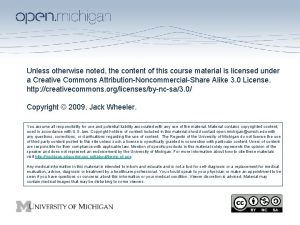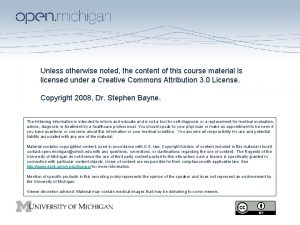Unless otherwise noted the content of this course










































- Slides: 42

Unless otherwise noted, the content of this course material is licensed under a Creative Commons Attribution 3. 0 License. http: //creativecommons. org/licenses/by/3. 0/. Copyright 2008, Bryce Pilz. You assume all responsibility for use and potential liability associated with any use of the material. Material contains copyrighted content, used in accordance with U. S. law. Copyright holders of content included in this material should contact open. michigan@umich. edu with any questions, corrections, or clarifications regarding the use of content. The Regents of the University of Michigan do not license the use of third party content posted to this site unless such a license is specifically granted in connection with particular content objects. Users of content are responsible for their compliance with applicable law. Mention of specific products in this recording solely represents the opinion of the speaker and does not represent an endorsement by the University of Michigan.

Open Dissemination and Access to Information Class 8 – October 24, 2008 SI 519 / Pub. Pol 688 Bryce Pilz Fall 2008

Schedule • • • 2: 10 – Intro; Announcements 2: 20 – Exercise 2: 30 – Questions / Current Events 2: 40 – Student Presentation: Cybersquatting 2: 50 – Student Presentation: Creative Commons 3: 00 – Open Content Licensing 3: 25 – Jacobsen Case 3: 45 – Break 4: 00 – Student Presentation: Government Docs 4: 10 – Student Presentation: MIT Open Courseware 4: 20 – Open Access

Intro

Plagiarism v. Copyright • • • These are different concepts Attribution? Is copyright infringement always plagiarism? Is plagiarism always copyright infringement? Who enforces? Other differences?

Copyright Enforcer Courts Penalty Damages; injunction Attribution Changing some words Not a defense Derivative work – still infringing Use of public domain work Not © infringement Plagiarism School / Employer / Peers Institutional penalty; public censure Defense Paraphrasing – still plagiarism without credit Plagiarism without credit

Next Week BY: Molly Kleinman (blog) http: //creativecommons. org/licenses/by/3. 0/deed. en

Exercise

Questions / Current Events

TM Fair Use – 2 kinds • Nominative Fair Use – Using TM to describe TM owner’s product (when only practical way to talk about product is to use TM) • Ex) For use in “Canon” – Confusion not addressed • Classic Fair Use – Using TM to describe your own product – Until 2004, courts split on whether confusion mattered

KP Permanent Make-up v. Lasting Impression (2004)

KP: Microcolor Case Source: Transcript of KP Permanent Make-Up, Inc. v. Lasting Impression I, Inc. , 543 U. S. 111 (2004), available at http: //www. supremecourtus. gov/oral_arguments/argument_transcripts/03 -409. pdf • You can call your store Best Buy, but others may fairly say their store provides the best buy • This can be a fair use, even if there is some confusion • But, confusion can be a factor in determining fair use

Obama CTO • • Push broadband Manage $50 B VC fund for green technologies Cybersecurity Jeff Bezos, Vint Cert, Steve Balmer, Ed Felton

Mongols trademark • Previously owned by motorcycle gang • Trademark ownership turned over to the government • The government can now seize people got wearing the logo • How will the government maintain the trademark?

Presentations • Cybersquatting • Creative Commons

“Public Licenses” • Open source software • Open content • Next?

Background • Concept is old – collaborating by disseminating material in an open fashion – Storytellers in Peshawar – Oxford English Dictionary – Disney – ARPANET – “Request for comments” (1969) – Unix (1974) – doujinshi

Need for “Public Licenses” • Copyright expansion – term; scope (derivatives); DMCA; lack of clarity for fair use • In general – it’s hard to just give stuff away – Others may use it improperly – Liability – Transaction costs (due to © formalities) • Hard to find you • Need to find you • Goal: Make protected materials more accessible and more negotiable

BY: chrys (flickr) http: //creativecommons. org/licenses/by/2. 0/deed. en

Stallman • 1984 – Trying to share software – But users couldn’t share the software of others

GNU Manifesto (1985) “Why I Must Write GNU: I consider that the golden rule requires that if I like a program I must share it with other people who like it. Software sellers want to divide the users and conquer them, making each user agree not to share with others. I refuse to break solidarity with other users in this way. I cannot in good conscience sign a nondisclosure agreement or a software license agreement. ” Richard Stallman Source: http: //www. gnu. org/gnu/manifesto. html

Commentary • “Stallman's vision is laid out in the GNU Manifesto. This manifesto is either a profoundly important document or the mimeographed ravings of some guy in the city park. I’ve never been entirely sure which. ” Eric Kidd (2000) Source: http: //static. userland. com/user. Land. Discuss. Archive/msg 019844. html

Free Software • 1984: Set up Free Software Foundation and started writing software • Free (as in free speech, not free beer) to: – 1) run the software for any purpose; – 2) study how the software works and to adapt it to your needs; – 3) redistribute copies of the software – 4) improve the software and distribute your improvements to the public

From “free” to “open” • 1991: Linus Torvalds comes along – Writes Linux Kernel; using much GNU software – Linux grew from a hobby to the third most used operating system in the world BY: -= Treviño =- (flickr) http: //creativecommons. org/licenses/by-nc-sa/2. 0/deed. en

Netscape Release • 1998 – Browser Wars • January 1998 – Netscape release its browser as “open source” – Worried that Microsoft could make the web proprietary if servers only able to interact with IE • Firefox, Safari, Konquerer all based off of Netscape’s code

Open Source Principles (Rosen) • 1) Free to use OSS for any purpose whatsoever • 2) Free to make copies of OSS and to distribute them • 3) Free to create and distribute derivative works • 4) Free to access the source code • 5) Free to combine open source and other software Source: Rosen, Lawrence. “Chapter 1: Freedom and Open Source” in Open Source Licensing: Software Freedom and Intellectual Property Law. Prentice Hall PTR, 2004.

Creative Commons • http: //www. youtube. com/watch? v=io 3 Br. AQl 3 so • http: //www. youtube. com/watch? v=VMZ 2 m. U XZEA 8

Open Access • http: //www. youtube. com/watch? v=g 2 JT 23 E 1 b. RE

NIH Open Access • Author must post articles reporting NIH funded research – NIH repository on Pub. Med Central • Author therefore must retain sufficient public access rights when granting publication rights to others

Source: http: //www. google. com/trends? q=copyright, open source, open access, creative commons

Source: http: //courseware. hbs. edu/public/cases/wikipedia/exhibits. html

Public License Legal Issues • 1) Scope of License – other than Jacobson, no U. S. cases construing these licenses • 2) Automatic Termination – easy to accrue large infringement damages using OSS • 3)Conflicting Licenses – 58 OSI- approved licenses; but at least 600 “open source” licenses exist – Even the top 8 OS licenses may be incompatible (ex: GPL and Mozilla Public License) • 4)Need for OS Policy – concern from investors

Jacobsen • Difference between contract law and copyright/ IP law

Jacobsen Ruling • P. 12 – “Copyright holders who engage in open source licensing have the right to control the modification and distribution of copyrighted material. ” • P. 12 -13 – “The choice to exact consideration in the form of compliance with the open source requirements of disclosure and explanation of changes, rather than as a dollar -denominated fee, is entitled to no less legal recognition. ” Source: Jacobsen v. Katzer (N. D. Cal. 8/17/2007)

Class Questions

Problem 1 • UM Library adopts CC license – Whether to use “noncommercial” restriction • Boss wants no restrictions other than attribution – everything should be free and open • Concerned about public perception of giving things away for others to make money • Student has question about sponsored research

Problem 2 • FSF Lawyer • Question about code that was not created with any OSS, and distributed by itself • But, it “calls” a spell-checker program that was released under the GPL v 2 and is available online. • Does your software need to be released under GPLv 2?

Problem 3 • Play online licensed under CC – share alike • Software licensed under: • Which license can be used to release software version of play?

Problem 4 • How to make money with software written using GPLv 2 components?

Problem 5 • Licensed song under CC – Attribution, Noncommercial, No Derivatives • You’d like to make slideshow using that music as background and show it to the class • Can you?

Background Materials

Open Access: the NIH Policy See slides 14 – 35 of Elaine Brock’s presentation at http: //www. research. umich. edu/policies/federa l/nih-pub-copyright. ppt
 Huey-ming tzeng
Huey-ming tzeng Unless otherwise noted meaning
Unless otherwise noted meaning Unless noted otherwise
Unless noted otherwise Unless otherwise agreed
Unless otherwise agreed Cristen chin model
Cristen chin model Noted
Noted Adventitious ideas examples
Adventitious ideas examples Static content vs dynamic content
Static content vs dynamic content Real content and carrier content in esp
Real content and carrier content in esp Romeo and juliet act 3 jeopardy
Romeo and juliet act 3 jeopardy A unless b
A unless b Unless you repent
Unless you repent The part can never be well unless the whole is well
The part can never be well unless the whole is well Oraciones unimembres
Oraciones unimembres Cramped holes literary devices
Cramped holes literary devices Cond in lisp
Cond in lisp In case unless
In case unless Unless you repent you will all likewise perish
Unless you repent you will all likewise perish Unless what
Unless what The weather has been nice but it may snow again any day
The weather has been nice but it may snow again any day Sandy feels dirty unless she bathes and changes
Sandy feels dirty unless she bathes and changes You finish your homework
You finish your homework Unless
Unless Unless lisp
Unless lisp The trust giant's point of view analysis
The trust giant's point of view analysis Chaine parallèle muscle
Chaine parallèle muscle Half brick wall in stretcher bond report
Half brick wall in stretcher bond report Course title and course number
Course title and course number Plain milling can be otherwise called as
Plain milling can be otherwise called as Ra 10912 reflection
Ra 10912 reflection Dissociative disorder not otherwise specified
Dissociative disorder not otherwise specified Employers must not place construction loads
Employers must not place construction loads Dissociative disorder not otherwise specified
Dissociative disorder not otherwise specified Dissociative disorder not otherwise specified
Dissociative disorder not otherwise specified Dissociative amnesia
Dissociative amnesia Human asset multiplier model
Human asset multiplier model R.a. 9344
R.a. 9344 Respect is over evaluation
Respect is over evaluation Respect is right evaluation
Respect is right evaluation Who sponsored house bill 393
Who sponsored house bill 393 Vẽ hình chiếu đứng bằng cạnh của vật thể
Vẽ hình chiếu đứng bằng cạnh của vật thể độ dài liên kết
độ dài liên kết Chó sói
Chó sói
